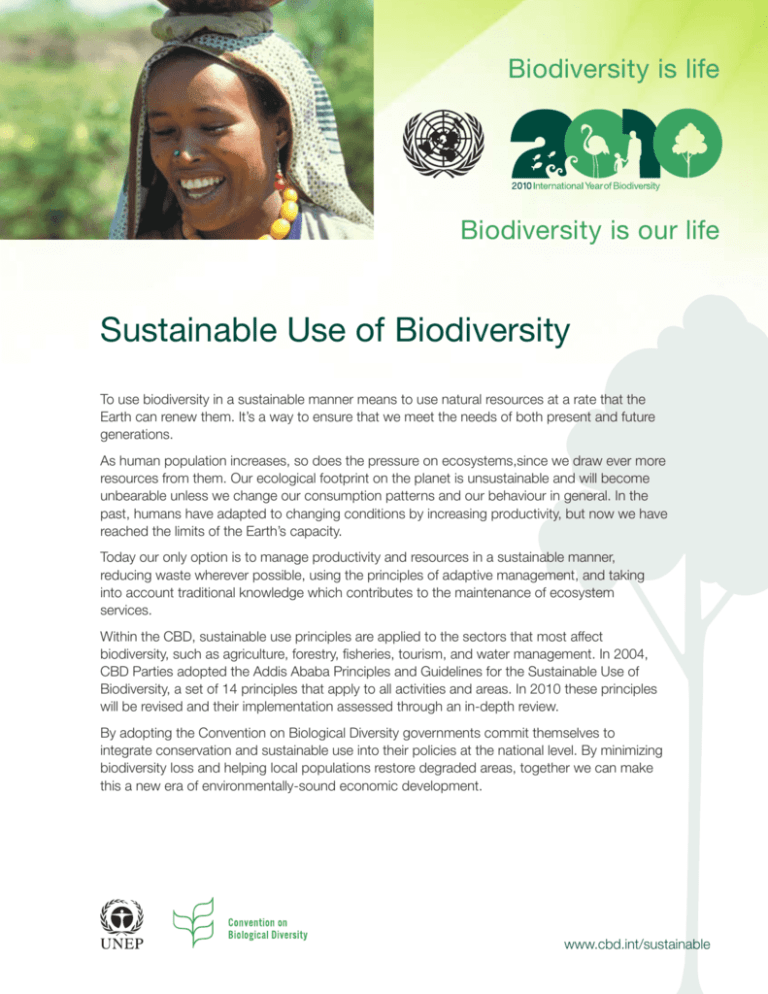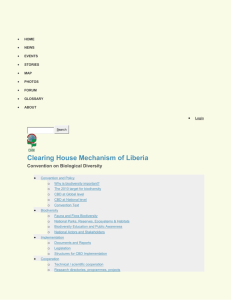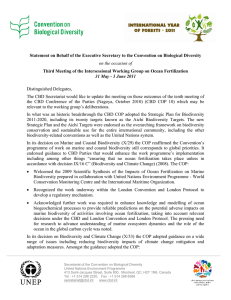Sustainable Use of Biodiversity - Convention on Biological Diversity
advertisement

Biodiversity is life Biodiversity is our life Sustainable Use of Biodiversity To use biodiversity in a sustainable manner means to use natural resources at a rate that the Earth can renew them. It’s a way to ensure that we meet the needs of both present and future generations. As human population increases, so does the pressure on ecosystems,since we draw ever more resources from them. Our ecological footprint on the planet is unsustainable and will become unbearable unless we change our consumption patterns and our behaviour in general. In the past, humans have adapted to changing conditions by increasing productivity, but now we have reached the limits of the Earth’s capacity. Today our only option is to manage productivity and resources in a sustainable manner, reducing waste wherever possible, using the principles of adaptive management, and taking into account traditional knowledge which contributes to the maintenance of ecosystem services. Within the CBD, sustainable use principles are applied to the sectors that most affect biodiversity, such as agriculture, forestry, fisheries, tourism, and water management. In 2004, CBD Parties adopted the Addis Ababa Principles and Guidelines for the Sustainable Use of Biodiversity, a set of 14 principles that apply to all activities and areas. In 2010 these principles will be revised and their implementation assessed through an in-depth review. By adopting the Convention on Biological Diversity governments commit themselves to integrate conservation and sustainable use into their policies at the national level. By minimizing biodiversity loss and helping local populations restore degraded areas, together we can make this a new era of environmentally-sound economic development. www.cbd.int/sustainable Fast Facts nn Despite the fact that sustainable use of biodiversity is widely included in national biodiversity strategies, unsustainable use and overexploitation remain major threats to biodiversity in several sectors, including fisheries, agriculture, and forestry nn Mangroves protect coastlines from erosion, protect coral reefs from siltation and act as nurseries for a variety of fish and shellfish. The major causes of mangrove decline are conversion to aquaculture, agriculture, and urban, residential and tourism development nn Sustainable activities can be applied in many sectors, including: organic farming; environmental impact assessments, certification and eco-labelling, quotas for fisheries; not using large nets; management of protected areas; reduction of bush fires; sustainable tourism nn About 300 million people depend on forests directly for their survival, including 60 million people of indigenous and tribal groups, who are almost completely dependent on forests nn As human population increases, the demand for fish is expected to grow, especially in developing countries nn Illegal logging and illegal harvesting of forest products are a serious problem, costing an estimated US$15 billion per year. Rare tree species and those with high value for timber or non-timber forest products are in danger of becoming locally extinct. Learn More The Addis Ababa Principles and guidelines for the Sustainable Use of Biodiversity n www.cbd.int/sustainable/addis.shtml Article 10 of the Convention on Biological Diversity: n www.cbd.int/decision/cop/?id=7749 COP decision VI/13 n www.cbd.int/decision/cop/?id=7187 COP decision V/24 on sustainable use as a cross-cutting issue n www.cbd.int/decision/cop/?id=7166 Desertification n www.greenfacts.org/en/biodiversity/l-2/4-causes-desertification.htm Secretariat of the Convention on Biological Diversity 413, Saint Jacques Street, suite 800 Montreal, Quebec, H2Y 1N9 Canada Tel.: +1 514 288 2220 Fax: +1 514 288 6588 iyb2010@cbd.int www.cbd.int/sustainable





